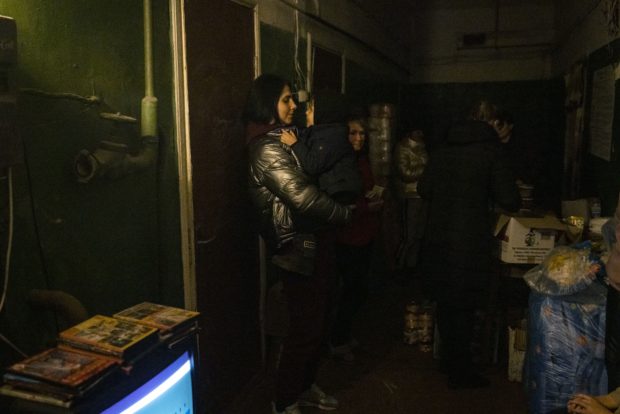
Residents gather in a shelter in the city of Severodonetsk, Donbass region, on April 6, 2022, as Ukraine tells residents in the country’s east to evacuate “now” or “risk death” ahead of a feared Russian onslaught on the Donbas region, which Moscow has declared its top prize. AFP
SEVERODONETSK, Ukraine — Maria hugged her six-year-old son Maxim close as the sound of shelling echoed nearby Wednesday in the under fire eastern Ukrainian city of Severodonetsk.
She did not want to flee her home even though the bombing from Russian forces has meant most residents have left.
“There’s no electricity, no water,” said the young woman, who lives with her husband and mother-in-law.
“But I prefer to stay here, at home. If we leave, where will we go?”
Severodonetsk is the most easterly city still held by Ukrainian forces and has become a deserted shell of its former self as Russia’s invading troops have made it a key target.
“The bombings? It’s like this all the time,” Maria said, after another explosion.
The frontline is very close. The city, with more than 100,000 inhabitants before the war, is almost empty.
About 400 civilians have been buried there since the war began, according to the Ukrainian governor of the Lugansk region Sergiy Gaiday.
Calls to evacuate
The weather was miserable on Wednesday as cold rain poured from the grey sky and filled potholes in the roads.
The conditions were not favourable for a feared major offensive that Ukraine believes Moscow’s forces are massing for as they look to claim the whole of the Donbas region for two separatist areas.
The frontline positions have not moved for a few days as both sides rely on their artillery.
A handful of people braved the search for supplies on a broad street leading from the city centre to a wood, beyond which the Russians are camped.
As strikes sounded they hurried along crouching down close to the walls.
An AFP team passed an elderly man walking next to a woman.
“I’m looking for something to drink. This woman wants bread. But they don’t sell it,” Yury said.
“I am afraid, very afraid, but I am 70 years old, so I don’t show it,” he said.
He needs medicine for his aching joints and leg but “there are no doctors, no nurses, and all the pharmacies are closed”.
The governor has called on people to evacuate the government-held Lugansk region, of which Severodonetsk is the capital.
A small yellow bus was parked in front of the cultural centre, the meeting place for people wanting to be evacuated.
Tamara Yakovenko, 61, came with her 83-year-old mother.
Four other people waited with them at the pick-up point.
“We have to leave…. Here we have to stay in the basement. It’s horrible. Every 10 or 15 minutes there are bombings,” Tamara said.
“We used to receive humanitarian aid, but now nobody remembers us. Some people try to cook outside on a fire… And boom, boom… everyone has to run back to the basement. All night until morning, there is no rest.”
Ukrainian troops
At the checkpoints at the entrance to the city, the Ukrainian troops had put on their raincoats.
There were few soldiers in the city. At the corner of one building stood a light armoured vehicle, covered with camouflage netting.
On the road heading West to the military hub of Kramatorsk there was little sign of troop movements.
Only a few empty army lorries and fuel trucks headed towards the front.
According to the regional governor, the Russians are concentrating their forces near Rubizhne, less than 10 km (6 miles) north of Severodonetsk.
Last night, Rubizhne was the target of shelling throughout the night, according to a resident, whose house looks out over the two localities.
RELATED STORIES
Fiji investigates arrival of Russian oligarch’s vessel, questions captain
After Biden remark, US yet to commit to its own genocide probe of Russia
Russia says over 1,000 Ukrainian marines surrender in Mariupol
Finland to make decision on Nato entry in coming weeks, not months